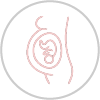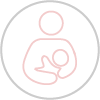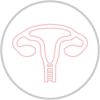Urinary Incontinence is defined as any involuntary leakage of urine, from the occasional dribble to total loss of control of the bladder. Many women suffer with this, on a huge spectrum of severity, within the first few months post delivery. For some women, symptoms can last much longer than the first few months, and if not addressed they could go on to suffer for years. Some women may not present with any problems immediately after childbirth, but only develop symptoms later in life. The most common urinary symptoms postnatally are Stress Urinary Incontinence (SUI) and urinary frequency. SUI involves the leaking of urine when you cough, sneeze, laugh, lift objects or exercise. Urinary frequency occurs because the bladder shrinks in size and becomes incapable of holding large volumes of urine, hence the need to empty more frequently.
The pelvic floor muscles are part of the pelvic floor. The pelvic floor covers the opening of your pelvis and is a set of muscles, tissues, ligaments and nerves that give support and correct positioning to the bladder, womb and rectum. The pelvic floor muscles primarily help to control the passing of urine from the bladder, and stool from the rectum, and therefore help to keep you continent. A healthy pelvic floor supports a baby during pregnancy and facilitates the baby’s delivery. It also enhances sexual intercourse.
As with any muscles in your body, the pelvic floor loses strength when it is stretched and damaged. When the muscles are not ‘fit for purpose’, women can struggle with urinary incontinence. Here are the reasons why your pelvic floor may be dysfunctional after childbirth…..
Causes of Pelvic Floor dysfunction:
- Weight and pressure of carrying baby in womb (increase weight with large babies, twins/triplets etc)
- Vaginal delivery, extreme stretching of pelvic floor
- Perineal tears and internal scarring
- Pain – pelvic pain, perineal pain, scar tissue
- Pelvic organ descent or prolapse
- C-Section – abdominal muscle weakness and pelvic organ descent
- Pudendal nerve damage during delivery (the nerve that supplies the bladder)
- Instrumental delivery – forceps, suction, manual removal of placenta
- Episiotomy (the surgical cut used to facilitate birth)
Physiotherapy for Urinary Incontinence following childbirth:
- In depth assessment of current gynaecological symptoms, urinary symptoms and concerns
- Assessment of the pelvic floor area (external) – position of perineum, scarring, skin and tissue condition
- Internal examination of the pelvic floor muscle and surrounding tissue (with consent) to assess tone, strength, endurance and quality of the muscles’ function. Assessment of sensation and nerve function.
- Bladder and bowel advice and re-training
- Teach correct pelvic floor muscle exercise technique and exercise regime
- Guidance on weight loss, diet and exercise,and return to activity/fitness
- Use of muscle stimulation and biofeedback as indicated
- Advice on intercourse and sexual function



